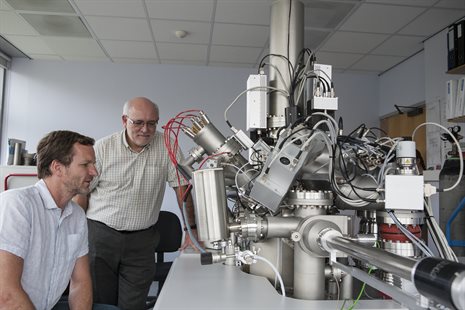 14 Jan 2019
14 Jan 2019
The University of Nottingham is the first university in the world to own and operate unique equipment which allows label-free chemical imaging of materials, cells and tissues, with the potential to transform research in these areas.
The new 3DOrbiSIMS is the first production instrument of its kind and will have applications in a multi-disciplinary range of research areas, including biomedical implants, drug delivery systems, developing strategies to tackle antimicrobial resistance, organic electronic devices and engineering applications.
Breaking new ground
Professor Morgan Alexander and Professor Paul Williams from the Schools of Pharmacy and Life Sciences have recently led the discovery of bacteria resistant materials that are now being trialled in catheters to reduce infection rates.
Professor Alexander explains why this new instrument is so important for the future of research breakthroughs like this: “This facility gives us the capability to identify biological molecules in samples from complex biological environments, such as the human body, without being restricted by our existing understanding. This is a very exciting prospect in areas where the knowledge of the fundamental processes underlying biological responses is still developing, such as in explaining why bacteria colonise certain plastics and not others. Equally it provides the opportunity to identify and locate known compounds such as drug molecules in biological samples like human cells, which is critical in the development of future generations of drug therapy. This capability has great application in both academic and industrially based research programmes; we are very excited about collaborating with colleagues from the UK and around the world.”
The 3D OrbiSIMS is a concept from the National Physical Laboratory, where the first prototype instrument is based. These two instruments put the UK in a very strong global position for molecular imaging to support academia and industry.
Planned projects using the 3DOrbiSIMS include; research into the fight against antimicrobial resistance where the insight provided can further the understanding of medical device colonisation and biofilm formation. Other projects include the localisation of nano therapeutics to support the development of intracellular therapeutic delivery of surface engineered nanoparticles and their identification in tissue such as skin. Projects within engineering will include the support of additive manufacturing, via detailed chemical analysis of complex 3D printed materials, as well the identification of complex organic deposits upon engine components to enable improved efficiency in the use of fossil fuels.
State-of-the-art 3D imaging
The 3DOrbiSIMS is a time of flight secondary ion mass spectrometer (ToF-SIMS) with unique state-of-the-art 3D imaging capability that achieves unprecedented mass resolution through the integration of a high specification OrbitrapTM mass spectrometer. The instrument is also capable of extremely high spatial resolution.
The facility is also complemented by high pressure freezing cryo-preparation facilities that enable biological samples to be maintained close to their original stateallowingthe native structure of hydrated samples such as stem cells and bacteria to be studied. The instrument allows label-free molecular characterisation, producing an uncompromisingly accurate portrayal of the true chemical 3D internal environment of a sample at high lateral (<100 nm) and depth (~3 nm) resolution.
The £2.5m investment for this new facility was made with the support of an award from the Engineering and Physical Sciences Research Council(EPSRC).
The 3DOrbiSIMS will be situated in the University of Nottingham’s Nanoscale and Microscale Research Centre(nmRC), a world leading inter-disciplinary research centre for materials characterisation at the micro and nano-scale.
Read more details on the University newspage